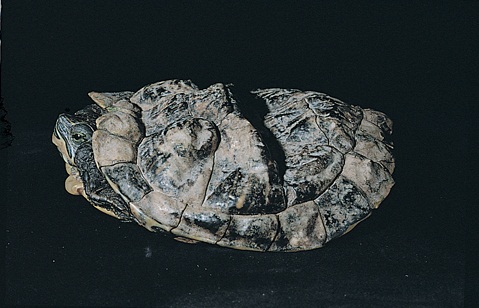Difference between revisions of "Reptiles and Amphibians Q&A 03"
(Created page with "[[|centre|500px]] <br /> '''This 15-year-old red-eared slider turtle had been raised since it was a hatchling on a diet of peeled shrimp and iceberg lettuce. At the time that i...") |
|||
| (2 intermediate revisions by 2 users not shown) | |||
| Line 1: | Line 1: | ||
| − | [[|centre|500px]] | + | {{Manson |
| + | |book = Reptiles and Amphibians Q&A | ||
| + | }} | ||
| + | |||
| + | [[File:Rep 03.jpg|centre|500px]] | ||
<br /> | <br /> | ||
| Line 11: | Line 15: | ||
|a1= | |a1= | ||
Chronic metabolic bone disease and secondary nutritional hyperparathyroidism due to a calcium-poor, phosphorus-rich diet. | Chronic metabolic bone disease and secondary nutritional hyperparathyroidism due to a calcium-poor, phosphorus-rich diet. | ||
| − | |l1= | + | |l1=Metabolic Bone Disease |
|q2=What would you do to confirm your diagnosis? | |q2=What would you do to confirm your diagnosis? | ||
|a2= | |a2= | ||
Radiographs revealed a deformed and poorly mineralised skeleton; blood calcium on the day of presentation was 4.6mg/dl. | Radiographs revealed a deformed and poorly mineralised skeleton; blood calcium on the day of presentation was 4.6mg/dl. | ||
| − | |l2= | + | |l2=Metabolic Bone Disease#Diagnosis |
|q3=How would you treat it? | |q3=How would you treat it? | ||
|a3= | |a3= | ||
| Line 23: | Line 27: | ||
Exposure to natural unfiltered sunlight or ultraviolet irradiation; oral vitamin D3 at a dosage of 1–4 IU/kg twice weekly. | Exposure to natural unfiltered sunlight or ultraviolet irradiation; oral vitamin D3 at a dosage of 1–4 IU/kg twice weekly. | ||
| − | |l3= | + | |l3=Metabolic Bone Disease#Treatment |
</FlashCard> | </FlashCard> | ||
Latest revision as of 17:22, 28 October 2011
| This question was provided by Manson Publishing as part of the OVAL Project. See more Reptiles and Amphibians Q&A. |
This 15-year-old red-eared slider turtle had been raised since it was a hatchling on a diet of peeled shrimp and iceberg lettuce. At the time that it was presented for examination, it was not using its hindlimbs; rather, when it was picked up and held vertically, they dangled loosely. The turtle’s shell was flat, deformed and markedly soft to the touch.
| Question | Answer | Article | |
| What is your tentative diagnosis? | Chronic metabolic bone disease and secondary nutritional hyperparathyroidism due to a calcium-poor, phosphorus-rich diet. |
Link to Article | |
| What would you do to confirm your diagnosis? | Radiographs revealed a deformed and poorly mineralised skeleton; blood calcium on the day of presentation was 4.6mg/dl. |
Link to Article | |
| How would you treat it? | Calcium gluconate (2.5mg/kg intracoelomically every 48 hours for one week). The diet should be changed immediately to include whole fish, freshly caught earthworms, calcium-rich collard leaves, and algae. Exposure to natural unfiltered sunlight or ultraviolet irradiation; oral vitamin D3 at a dosage of 1–4 IU/kg twice weekly. |
Link to Article | |
